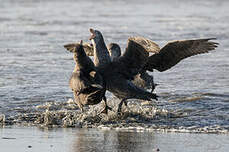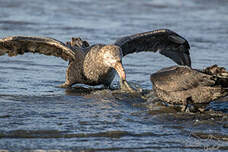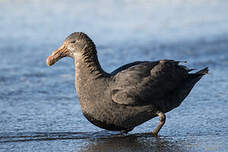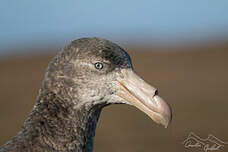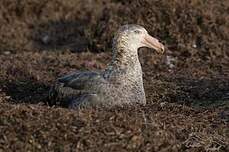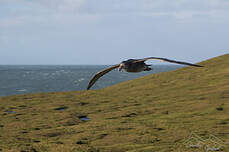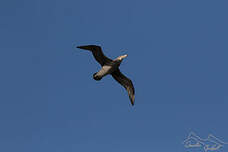Northern Giant Petrel
Macronectes halli - Pétrel de Hall
Identification
One of the largest petrels (along with the Southern Giant Petrel). The entire plumage is a greyish brown with the exception of the forehead, chin and throat, which are much lighter in color and have white feathers. The beak is large, horn coloured with a brown to reddish-brown tip. The nostrils are also very impressive. Immatures are entirely dark.
It can sometimes be difficult to differentiate from Macronectes giganteus which is generally much lighter, sometimes even almost white. With this species, the tip of the beak is greenish. It is not possible to differentiate the immatures of the two species in the wild.
The two species can sometimes hybridise; this is particularly the case for birds nesting on Gough Island (South Atlantic).
Subspecific information monotypic species
Foreign names
- Pétrel de Hall,
- Abanto marino subantártico,
- pardelão-subantártico,
- Hallsturmvogel,
- északi óriáshojsza,
- Noordelijke Reuzenstormvogel,
- Ossifraga del nord,
- nordlig jättestormfågel,
- Nordkjempepetrell,
- plavec tmavý,
- buřňák Hallův,
- Nordlig Kæmpestormfugl,
- tummamyrskyliitäjä,
- Grootnellie,
- petrell gegant subantàrtic,
- Jötunfýlingur,
- petrelec wielki,
- severni veleviharnik,
- Северный гигантский буревестник,
- キタオオフルマカモメ,
- 霍氏巨鹱,
- nordlig jättestormfågel,
- 北方巨鸌〔賀爾氏巨鸌〕,
Habitat
Behaviour character trait
If adults can be almost sedentary, staying only very close to colonies, young ones undertake long journeys virtually throughout the Southern Hemisphere. The Northern Giant Petrel is often gregarious. On feeding sites, it is dominated by its congeners M. giganteus and more often searches for food in the sea.
Dietfeeding habits
Male and female have different diets. The females mainly feed on cephalopods, krill, and sometimes on small petrels at sea. The prey are captured from the surface, but Northern Giant Petrels are capable of diving. The males are mainly scavengers, feeding on the corpses of all sorts of marine mammals and birds found on the coast.
Reproduction nesting
Northern Giant Petrels rarely nest in colonies. Their nest is a non-structured pile of grass that can be over 50 cm tall. Clutching typically begins in August with a single egg which is incubated for about 2 months. Chicks are covered in grey down on top and whitish underneath and are almost constantly covered by an adult for around 3 weeks. They only take to the skies at around 3 and a half to 4 months old. These birds don't reach sexual maturity until they're 6 to 7 years of age.
Geographic range
Threats - protection
Sources of information
- IOC World Bird List (v15.1), Gill, F and D Donsker (Eds). 2025-12-07.
- Albatrosses, Petrels and Shearwaters of the World, Onley Derek et Scofield Paul
- Field Guide to New Zealand Seabirds, Parkinson Brian
- Seabirds, an identification guide, Harrison Peter
- The Field Guide to the Birds of Australia, Graham Pizzey et Frank Knight
- xeno-canto, Sharing bird sounds from around the world,
- Avibase, Lepage Denis
- Vol. 1 - Handbook of the Birds of the World, Josep del Hoyo-Andrew Elliot-Jordi Sargatal
Other sources of interest
 Specification sheet created on
01/08/2023 by Georges Olioso
Specification sheet created on
01/08/2023 by Georges OliosoTranslation by AI Oiseaux.net
© 1996-2025 Oiseaux.net
- Accipitriformes
- Aegotheliformes
- Anseriformes
- Apodiformes
- Apterygiformes
- Bucerotiformes
- Caprimulgiformes
- Cariamiformes
- Casuariiformes
- Charadriiformes
- Ciconiiformes
- Coliiformes
- Columbiformes
- Coraciiformes
- Cuculiformes
- Eurypygiformes
- Falconiformes
- Galliformes
- Gaviiformes
- Gruiformes
- Leptosomiformes
- Mesitornithiformes
- Musophagiformes
- Nyctibiiformes
- Opisthocomiformes
- Otidiformes
- Passeriformes
- Pelecaniformes
- Phaethontiformes
- Phoenicopteriformes
- Piciformes
- Podargiformes
- Podicipediformes
- Procellariiformes
- Psittaciformes
- Pterocliformes
- Rheiformes
- Sphenisciformes
- Steatornithiformes
- Strigiformes
- Struthioniformes
- Suliformes
- Tinamiformes
- Trogoniformes



















